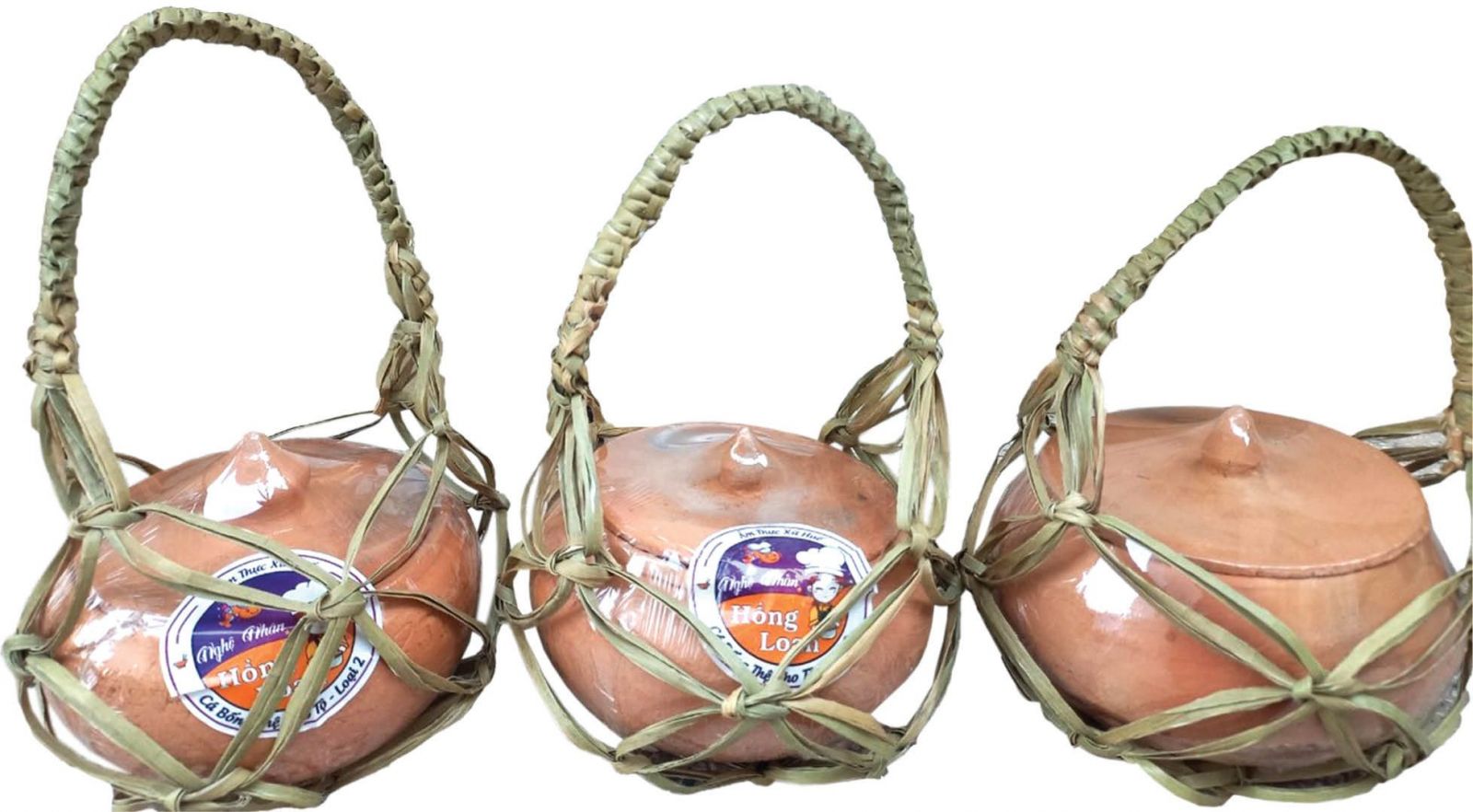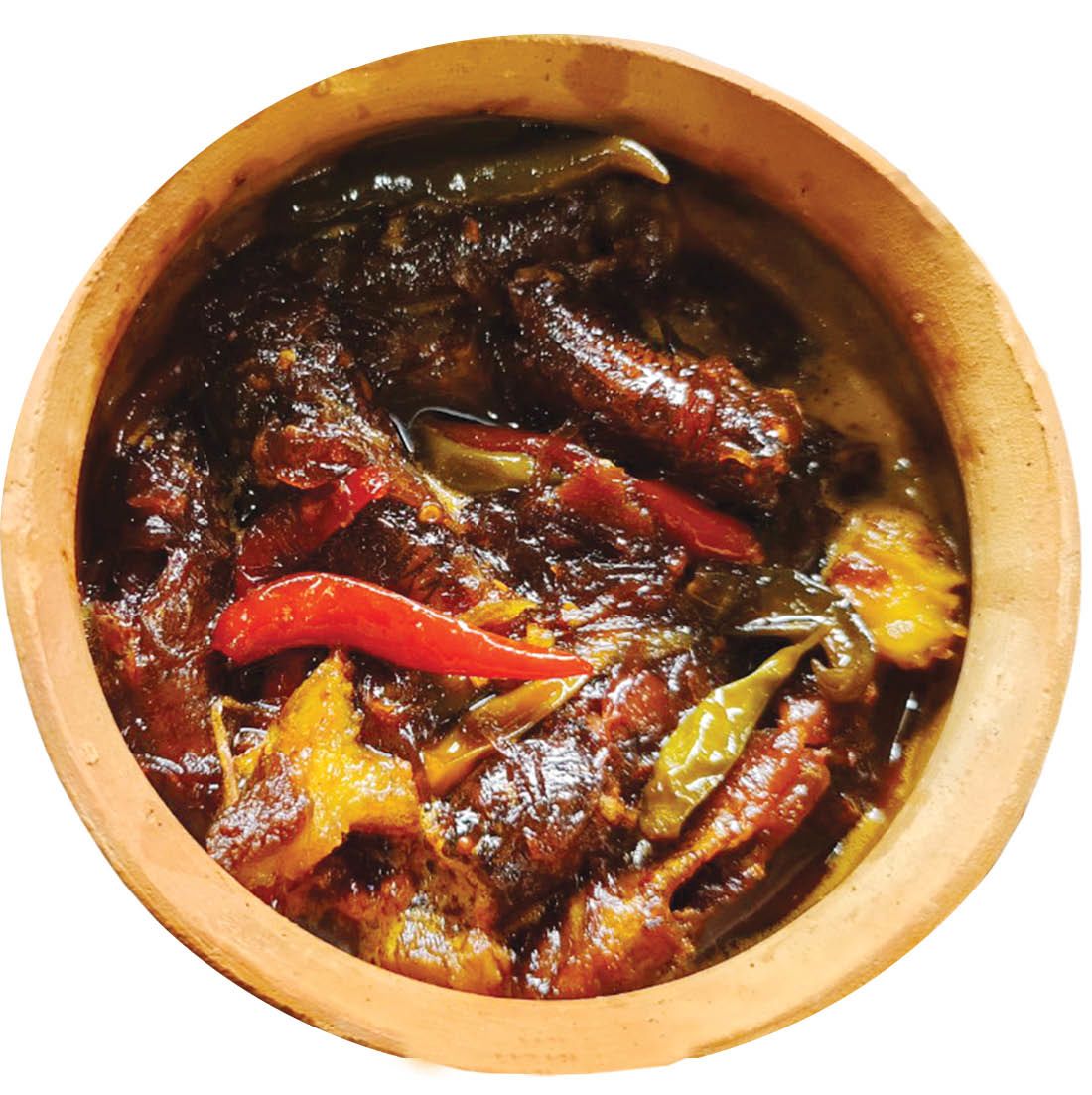
Cá kho om ngự (Fish braised in a small clay pot offered to the king) ready to ship to customers
“Delicious royal meal”
The image of the goby braised in om ngự (a small clay pot offered to the king) of Phuoc Tich Ancient Village, the fish hardening with enough fire, but still retaining appearance, curving, bright with amber, decorated with green red peppers... together with a few lines of introduction posted on the personal website by Ms. Nguyen Thi Hue, Director of Hue Viet Organic One Member Co., Ltd., quickly grabbed the attention of the online community with specific orders.
Ms. Nguyen Ngoc Thuy Tran, a diner recalls, “Not only is it visually stimulating, but I am also curious about om ngự; that's why I ordered it. I cannot list all Hue dishes that make me bewitched, and now I add this cá kho om ngự. This dish gets me to feel strangely familiar and cozy, like something deep inside me awakened.
Tran's feeling, like that of many people when Hue cuisine is mentioned, is "enjoying Hue cuisine as if enjoying its cultural quintessence". Is Hue food not only created by the skill of processing but also blended with the past and the present, for example, the dish “cá kho om ngự” in Phuoc Tich Village.
Phuoc Tich Ancient Village is noted for its 500-year-old pottery. Om đất (a clay pot) is a ceramic product of Phuoc Tich Village, used to cook rice, braise fish, and simmer meat. There are big and small ones which are traditionally called the first, second, or third pots; the choice of size of the pot is based on the number of eaters.

Cá kho om ngự (Fish braised in a small clay pot offered to the king)
Phuoc Tich om (a small clay pot) is also known as "om ngự" (a small clay pot offered to the king) because it used to be a utensil to offer to the king to cook rice for the king and favored by the Nguyen dynasties.
The ancient historical records referred a lot to the special custom of the famous villagers on the banks of this O Lau River: offering pottery to the court. It is called by the luxurious name of “Ngọc oa ngự dụng” - that is, a small clay pot offered to the king.
According to folklore, every year, the potters of Phuoc Tich Village had to twice take boats to bring om to the palace. The journey began along the O Lau River, to the Tam Giang Lagoon, then up the Perfume River and brought om to the Imperial Citadel. Therefore, the old folk verse has it:
Currently, “Ngọc oa ngự dụng” (a small clay pot offered to the king) is being revived through cá kho om ngự (fish braised in a small clay pot offered to the king), cơm niêu (rice cooked in a small clay pot)…
It is a bit chilly. In the cozy kitchen, culinary artisan Nguyen Thi Hong Loan is simmering the fish with om ngự. Under the fiery red brazier, the pot of braised fish gradually thickens; the fish soaked with spices harden; the shaking gold water blends with the green and red of the chilies, and the aroma begins to spread.
Braised fish with small fire take more than 3 hours to ripen. The fish get dry and harden but still retain the appearance, curving, and shining with amber. In a bit chilly weather, it is out of this world to bite the fish lightly, taste fatty plus the acridity of chili.
Ms. Loan said to be honored as a culinary artisan, she has to try cooking a great variety of Hue dishes, but she has never braised fish with om ngự.
“When suggested by Ms. Nguyen Thi Hue, I promptly agreed. Against braising fish in a metal pot, braised fish in an om (small clay pot) takes longer, but in return, the finished product retains its natural fat. In addition to goby, braising other types of fish in an om also provides a unique flavor," said artisan Hong Loan.
Last September, at the food fair in Dak Lak, cá kho om ngự was "launched". Visitors were promptly drawn by the dish that is both luxurious and intimate. After that impressive launch, cá kho om ngự was introduced at food fairs all over the country and always attracted diners," said Ms. Loan.
According to Ms. Nguyen Thi Hue, she desires cá kho om ngự to enter the market. Not only does it become a simple dish but it also has to be imbued with Hue's personality and culture. Therefore, she and artisan Nguyen Thi Hong Loan carefully carry out each stage before putting it on the market. If kept in a refrigerator, braised fish will be preserved for 30 days. The final product to the customer is braised fish put on a bamboo-woven base of a hanging basket made of Phong Binh grass cushion, accompanied by a label. “Cá kho om ngự will be an indispensable gift for every visitor to Hue, which is our expectation,” said Ms. Hue.
Ancient pottery awakened
On the last day of the year, Phuoc Tich Ancient Village is peaceful by the poetic river. We visited the house of Mr. Le Trong Dien, 74, seen as a walking encyclopedia of Phuoc Tich Village history. Leading us into the ancient rường house (a type of traditional architecture that appeared in Hue during the feudal period of Vietnam), where a lot of pottery has been produced by villagers from earlier times, including om ngự once offered to the king, Mr. Dien thoroughly talked about the ups and downs of pottery. Next to the porch, the craftsmen were continuously doing the steps of making om ngự in time for delivery to customers.
Cá kho om ngự present at food fairs, attracting many diners is a reassurance for the people still anxious about pottery like Mr. Le Trong Dien. Mr. Dien told us boastfully, "This shipment of 200 om ngự is ordered to braise fish, so all steps are carefully done, meeting the standards and firing temperature. At this time, we seem to be reviving with the craft a few decades ago," Mr. Dien said excitedly.
Besides Mr. Dien, young people like 8X guy Nguyen Thanh Bao, are also energized to conquer their passion for pottery when the project to support the construction of a traditional pottery kiln is taking shape. Many customers ordered products from his facility. "Every time back to Phuoc Tich, witnessing the villagers’ regret and anxiety over the pottery sinking into oblivion, I feel urged to act," said Ms. Nguyen Thi Hue.
According to Ms. Hue, to create a stable foothold for om ngự, she has connected to complete the project in Phuoc Tich Ancient Village with many items, including tours of experience, enjoying cơm niêu (rice cooked in a small clay pot), cá kho om ngự (fish braised in a small clay pot offered to the king) ... at the ancient rường house.
Those efforts are redoubled when Mr. Hoang Van Thai, Vice Chairman of Phong Dien District People's Committee said that the districtwill give priority to businesses that make an investment, enter into a joint venture or association to develop pottery in general and specialties of cơm niêu, cá kho tộ produced directly from Phuoc Tich. Simultaneously, it will connect with restaurants and hotels inside and outside the province to offer to sell “om ngự”.
Story: Hai Thuan
Photos: Tuan Khoa
